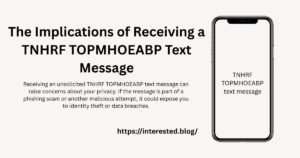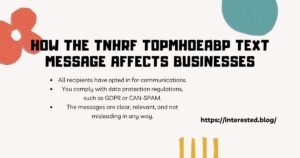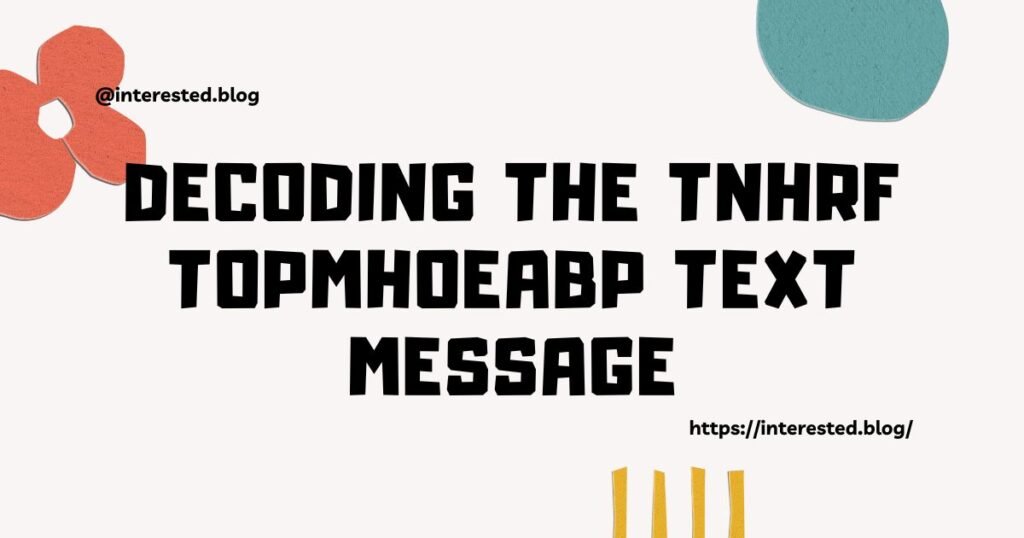Introduction
Have you recently received a mysterious text message that left you scratching your head, wondering what the acronym TNHRF TOPMHOEABP means? If so, you’re not alone. This strange combination of letters has been gaining attention in digital communication circles, but what does it really mean, and why is it so important?
In this article, we’ll explore the meaning behind TNHRF TOPMHOEABP text message, why they are creating a buzz, and the implications of encountering one. By the end, you’ll understand how to handle such messages safely and efficiently.
The Mystery Behind the TNHRF TOPMHOEABP Text Message
At first glance, TNHRF TOPMHOEABP seems like a random jumble of letters, but don’t be fooled. This acronym is not as cryptic as it appears. Each letter is an abbreviation for a technical term or a code in the realm of mobile communications. However, the full expansion remains somewhat elusive and varies depending on the region or the network provider involved. Some interpretations suggest that it could be related to mobile security systems, spam prevention filters, or even obscure marketing tactics.
Common misconceptions about TNHRF TOPMHOEABP text messages
When people first encounter a TNHRF TOPMHOEABP text message, they often assume it’s a technical glitch or a mistake. Others might believe it’s an urgent warning or something requiring immediate action. The truth is that these messages are typically generated by automated systems—whether they’re legitimate communications or unwanted spam.
First impressions vs. reality
At first, receiving a TNHRF TOPMHOEABP text message might spark curiosity or concern. But once you understand the nature of these messages, it becomes clear that they don’t always warrant panic. Some of these messages are harmless, while others may indicate a need for more caution.
The Origins of the TNHRF TOPMHOEABP Text Message
The use of TNHRF TOPMHOEABP text messages has its roots in evolving mobile communication technologies. These messages likely began as part of more advanced mobile security measures and evolved with the rise of SMS marketing, mobile banking, and digital authentication methods.
Why this term has recently become a topic of interest
With the growing volume of text-based spam, phishing schemes, and scams, terms like TNHRF TOPMHOEABP are receiving more attention. As mobile carriers and tech companies work to crack down on malicious messages, the occurrence of these acronyms has spiked, causing users to question their safety.
How the TNHRF TOPMHOEABP Text Message Works
TNHRF TOPMHOEABP text messages are sent through the same network infrastructure that handles all other SMS messages. However, these texts often come from shortcodes, long numbers, or international sources. The key difference lies in the underlying system that triggers the message and how it interacts with your mobile device’s security protocols.
Differences between TNHRF TOPMHOEABP and standard text messages
Unlike regular SMS messages that originate from human senders or automated systems with clear intentions (like promotions or alerts), TNHRF TOPMHOEABP messages may seem like a random string of code or unintelligible messages. This sets them apart from more conventional communications, and understanding this difference is crucial for identifying suspicious activity.
Step-by-step breakdown of how it operates in a communication network
- A service or system triggers a TNHRF TOPMHOEABP message.
- The message is sent via an SMS gateway to the recipient’s phone.
- The recipient receives the message, which may or may not be identifiable as spam or phishing.
- Depending on the mobile network’s filtering and security features, the message could either be flagged or delivered to the inbox.
Potential Reasons You Received a TNHRF TOPMHOEABP Text Message
There are several reasons why you might receive a TNHRF TOPMHOEABP text message:
- Marketing campaigns: Some businesses may use automated systems to send messages to large numbers of potential customers.
- Phishing attempts: Scammers may use these messages to gain access to your personal information.
- System alerts: Legitimate services or platforms could be sending you important notifications or updates.
What this text could indicate about your communication network
If you receive one of these messages, it could indicate that your mobile network has intercepted some form of automated or unsolicited communication. It could also suggest vulnerabilities in certain mobile networks or communication apps.
Possible sources: spam, marketing, or legitimate communications
- Spam: Often disguised as urgent requests or deals, TNHRF TOPMHOEABP text messages might be spam designed to trick you into clicking a link or revealing private details.
- Marketing: Some businesses use automated text systems to reach out to customers for promotional purposes.
- Legitimate communications: Occasionally, these texts may be sent by service providers to notify you of changes or updates to your account.
The Implications of Receiving a TNHRF TOPMHOEABP Text Message

Receiving an unsolicited TNHRF TOPMHOEABP text message can raise concerns about your privacy. If the message is part of a phishing scam or another malicious attempt, it could expose you to identity theft or data breaches.
Understanding the risks involved (scams, phishing, or data breaches)
These messages are often designed to catch you off guard, leading you to click on dangerous links, enter sensitive information, or download malicious files. This can result in:
- Scams: Fake promotions or warnings.
- Phishing: Attempts to steal personal or financial information.
- Data breaches: Unauthorized access to your personal information.
Potential consequences of interacting with such messages
Opening these messages or interacting with them can lead to significant security risks, including malware installation, unauthorized account access, or exposure to scams.
Is the TNHRF TOPMHOEABP Text Message Safe to Open?
Opening a TNHRF TOPMHOEABP text message from an unknown source can expose you to threats such as phishing, malware, and other types of cyberattacks. It’s essential to approach such messages with caution and never open attachments or click on suspicious links.
How to identify and avoid potential threats
- Look for inconsistencies in the message sender’s number or email address.
- Avoid clicking links in unsolicited messages, especially if the message creates a sense of urgency.
- Double-check any information provided in the message before taking any action.
Best practices for ensuring security
- Install anti-malware software on your phone.
- Enable two-factor authentication (2FA) wherever possible.
- Regularly update your phone’s operating system to patch security vulnerabilities.
What Should You Do If You Receive a TNHRF TOPMHOEABP Text Message?
If you receive a TNHRF TOPMHOEABP text message, here’s what you should do:
- Don’t open any links or attachments.
- Delete the message if you don’t recognize the sender or if it seems suspicious.
- Report the message to your mobile carrier or your device’s support team.
How to report the message and avoid further issues
Most mobile carriers provide a way to report spam or phishing attempts directly from your phone. You can forward the message to a designated short number, often provided by your carrier.
Contacting your mobile carrier for assistance
If the message persists or you believe it’s part of a larger issue, contact your mobile carrier’s customer service for further assistance. They can guide you on how to handle the situation or block the sender.
TNHRF TOPMHOEABP Text Message and Mobile Carrier Responses
Mobile carriers are constantly evolving their security measures to identify and block spam and phishing messages. When you report a TNHRF TOPMHOEABP text message, your carrier will typically analyze the source and take action to prevent future occurrences.
Possible actions taken by your carrier when you report the message
- Block the sender or the short code associated with the message.
- Investigate the origin of the message to determine if it’s part of a larger scam or marketing effort.
- Provide you with guidance on how to stay protected from similar messages.
Understanding how carriers detect and prevent such texts
Carriers often use advanced algorithms and AI-based systems to detect spam and phishing messages. They also rely on user reports to identify emerging threats.
Legal Considerations of the TNHRF TOPMHOEABP Text Message
Many countries have laws in place to protect consumers from unsolicited text messages. In the United States, for example, the Telephone Consumer Protection Act (TCPA) prohibits sending marketing messages without consent.
Your rights regarding spam and unsolicited communications
As a consumer, you have the right to opt-out of receiving marketing messages. If you receive unsolicited TNHRF TOPMHOEABP text messages, you can report them and take legal action if necessary.
Laws surrounding text message fraud and scams
Laws are also in place to combat fraud, scams, and identity theft related to text messages. Scammers who engage in deceptive practices could face significant legal consequences.
How to Block or Filter TNHRF TOPMHOEABP Text Messages
One of the most effective ways to protect yourself from unwanted TNHRF TOPMHOEABP text messages is to set up filters on your device. Most modern smartphones have built-in features that allow you to block messages from unknown senders or any suspicious sources.
Steps to block or filter messages on iPhone:
- Go to Settings > Messages.
- Enable Filter Unknown Senders. This will separate messages from unknown contacts into a separate list.
- For individual numbers, you can block them by opening the message and tapping Block Contact.
Steps to block or filter messages on Android:
- Open the Messages app.
- Tap on the three dots in the upper-right corner and select Settings.
- Choose Spam Protection and toggle on the feature.
- You can also block specific numbers by opening a message, tapping on the three dots, and selecting Block Number.
Popular apps and settings for blocking unwanted messages
There are several third-party apps that specialize in blocking spam or phishing messages, such as:
- Truecaller: Identifies and blocks unknown numbers and spam messages.
- Hiya: Blocks unwanted calls and identifies suspicious messages.
- RoboKiller: A call and SMS blocker that identifies spam messages and blocks them before they reach you.
These apps often use crowd-sourced data and advanced algorithms to detect potential threats and block them in real-time.
How to report the message to your phone’s service provider
In addition to blocking and filtering messages on your device, reporting the TNHRF TOPMHOEABP text to your mobile carrier is crucial. Here’s how you can report it:
- Forward the message to a specific number provided by your carrier (usually 7726, or SPAM).
- Contact your carrier’s customer support and inform them about the suspicious message.
Carriers will typically investigate these reports and take appropriate action against the source of the message.
How the TNHRF TOPMHOEABP Text Message Affects Businesses

For businesses, sending TNHRF TOPMHOEABP text messages can have serious repercussions. While SMS marketing is a legitimate channel for reaching customers, if the messages are unsolicited or appear suspicious, they can damage the brand’s reputation and violate consumer protection laws.
If your business uses SMS marketing, it’s essential to ensure that:
- All recipients have opted in for communications.
- You comply with data protection regulations, such as GDPR or CAN-SPAM.
- The messages are clear, relevant, and not misleading in any way.
The risks businesses face when sending text messages
Sending messages that resemble TNHRF TOPMHOEABP texts can backfire, leading to:
- Legal action: Violating anti-spam laws could result in fines or lawsuits.
- Loss of trust: Customers may feel violated or uncomfortable if they receive unwanted texts, leading to a decrease in trust and loyalty.
- Reduced engagement: Spam-like messages often get ignored, or worse, marked as spam, which can hurt your message’s delivery rates.
Best practices for businesses to avoid sending suspicious messages
To ensure your SMS marketing campaigns are effective and comply with legal requirements:
- Always obtain explicit consent from recipients before sending messages.
- Use clear opt-out options, allowing recipients to unsubscribe easily.
- Ensure that the content is relevant and not misleading.
- Personalize messages to make them feel more genuine and less like automated spam.
Impact of TNHRF TOPMHOEABP Text Messages on Personal Privacy
Receiving a TNHRF TOPMHOEABP text message can put your privacy at risk, especially if you interact with the message. Scammers and malicious actors use these texts to steal personal information such as your login credentials, credit card numbers, or even your social security number.
Tips for protecting your privacy while texting
- Don’t share sensitive information over text messages unless you are sure about the recipient’s authenticity.
- Be cautious of links: Always verify the source before clicking any link in a text message, even if it looks legitimate.
- Use encrypted messaging services: Consider using secure, encrypted messaging platforms like Signal or WhatsApp for sensitive conversations.
Understanding the importance of secure messaging platforms
Using a secure messaging platform adds an extra layer of protection, ensuring that your personal data remains private. Secure platforms use end-to-end encryption, meaning only you and the recipient can read the messages.
How TNHRF TOPMHOEABP Text Messages Relate to Mobile Marketing
In mobile marketing, TNHRF TOPMHOEABP text messages can be part of a broader effort to reach customers through SMS campaigns. However, if these messages are sent incorrectly or without proper consent, they may resemble spam or phishing attacks.
How marketers can avoid spam-like text messages
To avoid having your messages mistaken for spam or TNHRF TOPMHOEABP texts:
- Always ask for explicit consent before sending marketing messages.
- Make sure the content is relevant and adds value to the recipient.
- Segment your audience to ensure the messages are targeted to those who are most likely to engage.
The fine line between effective marketing and violating privacy
Marketers must walk a fine line between delivering effective marketing and respecting consumer privacy. While personalized, timely messages can engage users, overly aggressive or unsolicited messages can result in negative reactions, including being flagged as spam.
TNHRF TOPMHOEABP Text Message and Digital Security
Text messages can be a gateway for cybercriminals to gain access to your sensitive information. A TNHRF TOPMHOEABP text message may carry hidden dangers such as malware, phishing attempts, or links to fraudulent websites.
How to keep your mobile device secure against such threats
- Install antivirus software to detect and prevent malicious activities.
- Enable multi-factor authentication (MFA) wherever possible to add an extra layer of security.
- Regularly update your phone’s operating system to fix any security vulnerabilities.
Importance of using two-factor authentication (2FA)
Two-factor authentication adds an extra layer of security to your accounts, reducing the likelihood of unauthorized access. Always enable 2FA on services that support it, especially for sensitive accounts such as banking and social media.
The Role of AI in Detecting TNHRF TOPMHOEABP Text Messages
Artificial Intelligence (AI) plays a crucial role in identifying and filtering out TNHRF TOPMHOEABP text messages before they reach users. Machine learning algorithms can analyze patterns in text messages, identify potential spam or phishing attempts, and block them in real time.
AI-powered apps for spam message detection
There are several apps that use AI to detect and block spam messages, including:
- Truecaller: Uses AI to identify potential spam and block unwanted calls and messages.
- RoboKiller: Uses machine learning to detect and stop unwanted text messages and phone calls.
The future of AI in improving text message security
As AI technology continues to evolve, its ability to detect and block sophisticated scams, such as TNHRF TOPMHOEABP messages, will only improve. In the future, AI-powered security systems will likely become an essential part of mobile devices, providing real-time protection against text message-based threats.
What You Should Know About Spam and Phishing Attacks Related to TNHRF TOPMHOEABP Text Messages
It’s important to understand the distinction between spam and phishing:
- Spam messages are unsolicited and often irrelevant, such as promotions or offers you didn’t ask for.
- Phishing messages, like TNHRF TOPMHOEABP, are more dangerous, as they attempt to trick you into revealing sensitive information or clicking on malicious links.
How phishing schemes use TNHRF TOPMHOEABP messages
Phishing scams often disguise themselves as legitimate organizations, using TNHRF TOPMHOEABP messages to make you believe they’re a trusted source. These messages may ask you to update account information, reset passwords, or confirm banking details—often leading to identity theft or fraud.
Recognizing phishing attempts disguised as legitimate messages
To recognize phishing attempts, look for:
- Urgency: Messages that create a sense of panic or urgency (e.g., “Immediate action required”).
- Suspicious links: Hover over links to see if they lead to unfamiliar or misspelled web addresses.
- Unusual sender numbers: Messages from unfamiliar shortcodes or random numbers should be treated with caution.
Final Thoughts
In today’s digital landscape, TNHRF TOPMHOEABP text message are one of many security challenges mobile users face. Whether they’re part of a marketing campaign or malicious attempts at phishing, understanding how to identify, handle, and protect yourself from these messages is crucial. By following best practices for mobile security and staying informed, you can navigate the digital age with greater confidence and safety.
FAQs:
Q. What is the purpose of a TNHRF TOPMHOEABP text message?
It can be a marketing message, phishing attempt, or system-generated notification, often containing unsolicited or suspicious content.
Q. How can I safely respond to a TNHRF TOPMHOEABP text message?
Avoid interacting with any links or attachments, and report the message to your mobile carrier.
Q. What are the risks of clicking on links in a TNHRF TOPMHOEABP message?
Clicking on links can lead to phishing scams, malware downloads, or identity theft.
Q. How do mobile carriers prevent TNHRF TOPMHOEABP messages?
Mobile carriers use spam filters, AI-based detection systems, and user reports to identify and block such messages.
Q. Can businesses avoid sending spam-like TNHRF TOPMHOEABP messages?
Yes, businesses can ensure compliance with opt-in consent, clear messaging, and transparent practices to avoid appearing as spam.
Read More Content: KPSchedule


